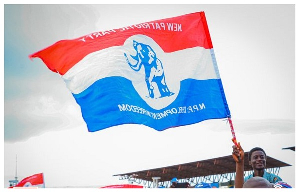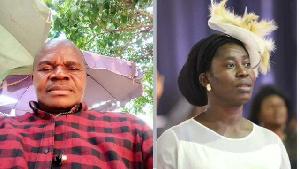A CASE STUDY OF THE ROLE OF THE NSOATREMAN RURAL BANK LTD.
The author looks at the poverty level in Ghana and how Nsoatreman Rural Bank Ltd and how the Bank employs its Credit facilities With Education to support the Governments Programme to alleviate poverty in the Country.
He tries to lay the foundation for the truth that an efficient micro-finance institution stands out as a tool for economic development. Philip Appiah-Mensah takes a close look at the disparities in poverty by considering gender and its effects on national development.
The study explains the methodology of Nsoatreman Women Empowerment Scheme and how it has impacted on the women in the Banks catchment area.
INTRODUCTION
GHANA AS A DEVELOPMING COUNTRY:Ghana is one of the world?s poorest countries with an annual per capital income of US $364 with a population of 18million.
One of the fundamental problems that have faced the country is the persistent reliance on the export of a few primary products with little or no value added (cocoa, gold, timber and others). This has made the economy vulnerable to price fluctuations dictated by buyers in the developed economies.
The low earnings from primary products have meant low revenue to the country. This turn has made it difficult to create meaningful wealth in the country. Ghana?s economy, since the early 1990s, has been characterized by high rates of inflation, high interest rates, continuous depreciation of the cedi, (the country?s currency) dwindling foreign reserves, excessive public debt overhang and stagnant economic growth. Extensive liberalization and adjustment in the 1980?s produced some growth in services and mining but did little to produce and sustain growth in agriculture and manufacturing.
As a result, both growth and incomes have remained stagnant. The stagnant growth of the economy in the 1990?s has produced less than acceptable levels of poverty reduction.
Spending on social programs for poverty reduction such as health and education has low and constraining to poverty reduction. For instance, the level of spending on health and education at 2.0% and 2.8% of GDP respectively are much lower than African averages with a disproportionate amount of the resources used for personnel emolument and administration.
Over the past ten years, Ghana has experienced growing and deepening poverty an evidence of intensification of vulnerability and exclusion among some groups and in some areas, especially in the north of the country and the central region. Moreover, population growth during the period far outstripped the rate of decrease in poverty levels.
Five out of ten regions in Ghana had more than 40% of their population living in poverty in 1999. The worst affected being the three Northern savannah regions (the Upper East, Upper West, Northern region). Nine out of ten people in the upper East, eight out of ten in Upper West, seven out of ten in Northern Region and five out of ten in Central and Eastern Region were classified as poor in 1999.
ii) A DEFINITION OF POVERTY
Poverty is recognized as multi-dimensional with complex interactive and causal relationships between the dimensions. For purposes of the Ghana poverty Alleviation strategy, poverty is defined as unacceptable physiological and social deprivation. This may be caused or exacter bated by:
? Lack of macro-economic stability that erodes the resources of the poor through inflation and other variables.
? The inability of the national economy to optimize benefits within the global system
? Low capacities through lack of education, vocational skills, entrepreneurial abilities, poor health and poor quality of life.
? Low levels of consumption through lack of access to capital, social assets, land and market opportunities.
? Exposure to shocks due to limited use of technology to stem effects of droughts, floods, army worms, crop pests, crop diseases, and environmental degradation.
? Habits and conventions based upon superstition and myths giving rise to anti social behaviour.
? The lack of capacity of the poor to influence social processes, public policy choices and resource allocations.
? The disadvantaged position of women in society. ? Other factors leading to vulnerability and exclusion.
THE SCOPE OF POVERTY IN GHANA
Poverty has many proportions. Therefore a range of indicators is needed to inform the range of policies to tackle the causes and mitigate the consequences of poverty. Households and communities may be characterized as poor based on lowness of income, malnutrition, ill health, illiteracy, lack of access to safe water and sanitation facilities, and general insecurity.These conditions combine to keep households and whole communities in persistent poverty. The analysis here therefore focuses on three dimensions of poverty: income or consumption poverty, lack of access to basic services, and deprivations in human development. The analysis is based on the Ghana Living Standards Survey (GLSS4) conducted by the Ghana statistical services over the period April 1998 ? March 1999. It also makes use of several supplementary data. Notably, the Participatory Poverty Analysis (PPA) survey administered in 36 sample communities from 14 districts in 6 regions provides qualitative data on perceptions of poverty.
POVERTY DISPARITIES BY GENDER
The study so far shows that poverty in Ghana has important gender implications as Females represent 50.5% of the total population, with regional variations of 49% in the Western region to 52% in the Central region. The evidence also suggest that regions experiencing the least reductions (or experiencing increases) in poverty levels (Central, Eastern, Northern, Upper East and Upper West) also tend to have female population in the range of 50 - 52 percent.Incidentally, these regions also tend to the rural areas.
Studies have shown that women experience greater poverty, have heavier time burdens, lower rates of utilization of productive resources and lower literacy rates. Gender disparities exist with respect to access to and control of a range of assets including direct productive assets such as land and credit, human capital assets including education and health, and social capital assets such as participation at various levels, legal rights and protection. Lack of start up capital and resources for any kind of income generation enterprise and lack of labour in smaller households prevent women from escaping poverty.
Some socio-cultural factors continue to perpetuate the gender in equities in access to and use of services and also contribute to such situations as the inequitable allocation of food within the household, leading to malnutrition-notably among women and children. Gender ?based violence also has important health, economic and political implications.
The connection between education, female household heads and income earning capability is a good reason to worry about the fact that only 6% of females aged 15 years and over had attained higher than secondary school education. Nearly 35% of all household heads are females. About 61% (53%) of female household heads in the urban (rural) area fall in the poorest 20% of the population. Most important of this statistics is that female poverty entails further deprivations that manifest in children?s significant under nourishment and infant mortality.
MICROFINANCE AS A POVERTY REDUCTION TOOL:
In development circles, micro-finance is seen as a tool for poverty reduction due to the appropriateness of its service delivery mechanisms for targeting the productive poor micro-finance as a tool for poverty reduction targets the poor in rural and urban communities.In identifying the poor in Ghana, the following characteristics are usually considered. The poor
? Have little or no education
? Lack access to information and support services for business development
? Usually lack access to institutionalized credit;
? Lack access to investment opportunities for the diversification of their enterprises.
? In Ghana, this profile describes a significant number of the poor in our rural and urban communities, especially women.
TARGET CLIENTELE
The target clientele of identified categories of Micro finance Institutions is basically in tandem with the characteristics of the poor in Ghana.It is the Norm for Micro-finance Institutions (MFI?s) in Ghana to simply target Micro and Small Scale Enterprise (MSE?s) as well as the productive poor categories which include;
? Women in the informal sector;
? Unemployed Youth
? Subsistence and Small Scale Producers in the agricultural sector
? Vulnerable groups in Ghana; due to the isolation and inaccessible nature of the geographic terrain;
? Disabled persons
NSOATREMAN RURAL BANK LTD
Nsoatreman Rural Bank Ltd (NRB) was established in 1984, and was in the same year licensed to operate the business of banking by the Bank of Ghana (BOG).Nsoatreman Rural Bank was established at a time when most of the existing banks were failing to address the very needs of the rural poor. This being access to micro-credit loans as a way of improving upon their socio-economic conditions. Starting as a community bank and obtaining its capital base mainly through the financial contributions of inhabitants / non inhabitants of its catchment area in the form of ordinary share holdings. Currently the bank has about seven thousand six hundred shareholders with women forming about 61%. The head office of the Bank is located in a town called Nsoatre, but has branches in neighbouring Communities such as , Sunyani, Jinijini, Yamfo, Chiraa and Techiman.
Operating in Four (4) districts in the Brong Ahafo Region, Sunyani, Berekum and Techiman and Tano Districts, Nsoatreman in its bid to help alleviate poverty in its catchments area has targeted rural poor women who on their own have no collateral security to access loans from the bank. Typically, these women have an average annual income of less than $200 and are involved in activities such as marketing, petty commerce and basic agro-processing.
The Bank has continuously increased its total resources, in assets (in particular the loan portfolio) and deposits. Currently it has been able to mobilize up to 4.48 billion cedis in savings deposit, grants as well as in concessional loans.
GROUP LOANS UNDER THE NSOATREMAN WOMEN EMPOWERMENT SCHEME
The program Nsoatreman Women Empowerment Scheme is a credit with Education program introduced in 1996 by the Bank in partnership with Freedom From Hunger (FFH) a US based NGO. It is an innovative micro-finance program, which is aimed at improving health and nutritional status of these women and their families.FFH provided technical training in microfinance as well as credit funds to NRB. An interest of 15% per cycle of 4 months was charged, repayments from the initial loans disbursed as well as Nsoatreman?s own contribution of 2.5 billion was able to serve a total of 3,050 women at the end of the partnership in June 1999 at which the program achieved operational sustainability.
During the program implementation program expenses were covered from income earned by the bank on loans given to the Credit and Savings Associations either in the form of interest, fees and commissions Average repayment rate was about 98%.
METHOD OF OPERATION
The slant of this program involves organizing five or six women into solidarity group. Five or six of the solidarity groups within the same community then join Credit Savings Association of 30 to 36 women. Under this each member of the solidarity group guarantees one another in case of default.Each association elects a President, Treasurer, Porter and Educational Animator and a Secretary among its members to run its affairs.
Newly formed Credit Associations undergo weekly training sessions for a minimum period of four weeks on groups? dynamics, business skills and health / nutrition.
After an association has undergone the required training, required loans are disbursed after which weekly savings are made and the Credit Officers collect repayments.
Each association meets once a week with one of the Bank?s credit officers (promoters) for 75 minutes. Thirty (30) minutes of the meeting time is devoted for educational sessions. The initial loan given is 100,000 cedis per person and each subsequent cycle increased by 50%.
The loan plus the interest in repaid in a period of 16 weeks. The women are engaged in such activities as petty trading, cooked food selling, fish mongering, hairdressing etc.
With the changing economic situation in the country such as high inflation, the Bank plans to increase the loan size to 500,000 cedis.
The borrowers contribute 1% of the loan disbursed into a group fund that could be assessed by any of the association members.
This micro-finance portfolio has been growing at an average rate of 41% every half year and over 3000 women have benefited from this program.
The program has become popular with the people and there is a rush on the bank by women in the community to participate in the program due to the positive impact it has had on the lives of the beneficiaries.
Currently the Bank is funding the credit with Education program which has been expanded from its own coffers and as August 2000, the outstanding loan including interest totaled 797 million cedis with a beneficiary base of 3,050 from 101 groups. Repayment rate is 100% It has developed strategies to be able to reach the poor. The strategies include area investigation, group mobilization, group training and equipping staff.
COMMUNITY INVOLMENT/ PARTICIPATION.
The program participants include, women above 18 years at the Banks catchment areas.Chiefs, elders and opinion leaders of these towns are actively involved right from the program concept and they are first and foremost tasked with the responsibility of organizing the members into groups.
*In situations of loans default, the Chiefs and Elders are involved in the recovery of loans.
*Given the necessary training women can be good leaders not only for their immediate family but also to the entire community within which they live.
*Group lending reduces the transaction cost of credit.
*In group lending group formation and animation, pre-determines the success of the project
*The informal sector if properly natured, can serve as a source of deposit mobilization for commercial Banks.
*Time delivery of credit to group beneficiaries ensures high recovery.
*Using the group methodology, micro finance can have a wider outreach than normal commercial banking loan products.
*Credit With Education is another source of disseminating health and nutrition messages to the whole community
*Given the necessary credit, the confidence of women in the society build up. This is shown by the involvement of women in the community activities.
*Micro Finance can lead to the generation of employment for most of these women.
BY PHILIP APPIAH-MENSAH
GENERAL MANAGER, NSOATREMAN RURAL BANK LTD
P:S This is an abridged version of an award winning research Paper presented at the 7th Annual Micro Enterprise Conference of the Wilkinson Students Centre, Brigham Young University United States, by Phillip Appiah-Mensah, General-Manager, Nsoatreman Rural Bank.
Views expressed by the author(s) do not necessarily reflect those of GhanaHomePage.
GENERAL MANAGER, NSOATREMAN RURAL BANK LTD
P:S This is an abridged version of an award winning research Paper presented at the 7th Annual Micro Enterprise Conference of the Wilkinson Students Centre, Brigham Young University United States, by Phillip Appiah-Mensah, General-Manager, Nsoatreman Rural Bank.

Views expressed by the author(s) do not necessarily reflect those of GhanaHomePage.














